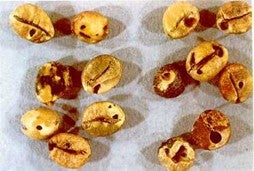Getting to the bottom of common coffee myths
Whether it be from an organic coffee company trying to market their products as superior or a random TikToker repeating misinformation they’ve heard, there seems to be a lot of false information regarding coffee regulations and processing going around lately. From valid concerns about pesticides and mold to misinterpretations of U.S. Food and Drug Administration regulations regarding allowable amounts of insects, it seems we have quite a bit of coffee myths to clear up here.
So grab a cup of your favorite pesticide (I’ll explain this in a bit), and let’s do this.
Myth #1: Conventional coffee is steeped in synthetic fertilizers and pesticides
Truth: First off, this is something that is being perpetuated by a certain organic coffee company as a way to market their products. I’ve seen several of their Facebook ads, claiming that conventional coffee is “steeped in synthetic fertilizers, pesticides, herbicides, fungicides and insecticides.” I don’t doubt that some of these companies have decent coffee, but to claim that conventional coffee is “steeped in synthetic fertilizers and pesticides” just shows a complete lack of understanding of how fertilizers and pesticides are even used. No foods, coffee included, are steeped in pesticides.
By the way, literally all coffee contains a pesticide that is an addictive neurotoxin known to kill insects. Consuming too much can lead to restlessness, rapid heartbeat, vomiting, and even death! This pesticide is the reason why many consume coffee in the first place. It’s called 1,3,7-Trimethylxanthine — otherwise known as caffeine.
And of course, pesticides can be used in both conventional and organic farming practices, but that doesn’t mean a harmful amount makes it into your morning cup of joe. Coffee processing includes removing the bean from the outer fruit, and roasting coffee means subjecting the beans to heat of more than 400 degrees F. Pesticides residue limits are set on green coffee beans, and the roasting process has been found to significantly reduce those residue levels even further.
Myth #2: Mold and mycotoxins in coffee are making you sick
Truth: Evidence shows that mycotoxins are present in a large percentage of green coffee beans (before roasting). Moldiness in green coffee may occur during curing, drying, and storage periods, however, this is a well-known concern in which coffee growers have found effective ways to mitigate. Wet processing gets rid of most of the molds and mycotoxins. In addition, crops get discarded if they exceed a certain level.

Roasting the beans also helps to kill molds that produce mycotoxins and has been shown to reduce ochratoxin A (OTA) levels by 69 to 96 percent. The amounts present in brewed coffee are far below safety limits. A European study looked at 633 final coffee product samples for occurrence of OTA. No OTA was found in over half of the samples, while the remaining samples contained such low levels that four cups of coffee per day would provide only 2 percent of the OTA exposure deemed safe by the Joint FAO/WHO Expert Committee on Food Additives.
Myth #3: Decaf is worse because the caffeine is chemically extracted with nasty solvents
Truth: In solvent-based caffeine extraction processes, a chemical solvent, such as methylene chloride or ethyl acetate, is added either directly or indirectly to selectively remove the caffeine. The concern arises when these solvents come in direct contact with green coffee beans during the direct solvent-based extraction method. However, in the case of methylene chloride, the FDA sets residue limits at a level not to exceed 10 parts per million (0.001 percent) in decaffeinated roasted coffee and in decaffeinated soluble coffee extract (instant coffee).

In practice, the levels are closer to one part per million, if any at all. That’s because the roasting process takes place at a minimum of 400 degrees F, while methylene chloride vaporizes at 104 degrees F. Not to mention the brewing process, which then takes place around 200 degrees F. Ethyl acetate can also be used for direct solvent extraction and is considered to be more “natural” since it occurs naturally in some fruits like apple, apricot, banana, grape, berries, melon, papaya, peach, pear and pineapple, and products such as vinegar, wheat and rye bread, cheeses, butter, alcoholic and non-alcoholic beverages. Ethyl acetate is produced commercially from ethyl alcohol and acetic acid. Like methylene chloride, it is very volatile with a boiling point of 170.8 degrees F, so only trace amounts, if any at all, survive the roasting and brewing temperatures.
So in summary, decaf is not unsafe due to scary sounding chemical solvents.
Myth #4: Ground coffee can contain up to 10 percent cockroaches
Truth: There’s a recent viral video going around stating that the FDA allows up to 10 percent cockroaches in ground coffee. Although this is based on a bit of truth, the actual regulation is being misinterpreted. The FDA regulatory action guidance states: “The following represents criteria for direct reference seizure: Insects and Mold — an average of 10 percent or more by count of green coffee beans are insect infested, including insect damaged, or moldy.” So, this is not the same as stating that 10 percent of ground coffee can be cockroaches.
What the regulation is actually stating is that up to 10 percent by count, so 10 out of 100 green coffee beans can contain insect parts, insect damage and/or mold, which we discussed previously. Remember, the green coffee beans are then roasted at 400 degrees F and brewed at 200 degrees F, so although this may sound unappetizing, it doesn’t present a safety issue.

The major pest attacking coffee beans is the coffee berry borer beetle. The coffee bean weevil is another common pest that may cause insect damage. It wouldn’t be practical to not allow any insect parts or damage, otherwise the alternative would be actually steeping the green coffee beans in pesticides, which ironically is one of the other common myths, or we’d need to throw out a lot of perfectly safe product. Not to mention, many cultures eat bugs as a standard part of their diet. After all, it is all natural and just a bit of extra protein.
Studies have shown that up to 400 milligrams (mg) of caffeine a day appears to be safe for most healthy adults. In addition, coffee consumption is associated with more benefit than harm for various health outcomes at three to four cups a day. So, don’t let any of these myths scare you away from enjoying your morning brew.
If someone is trying to scare you about a food or an ingredient, but they’re not specifying dose and providing evidence of harm to humans at doses consumed, they’re either clueless, they’re trying to deceive you and/or they’re trying to sell you something. And in this case, a lot of this misinformation is being spread by coffee companies attempting to scare you about their competitors’ brands.
Food Science Babe is the pseudonym of an agvocate and writer who focuses specifically on the science behind our food. She has a degree in chemical engineering and has worked in the food industry for more than decade, both in the conventional and in the natural/organic sectors.



